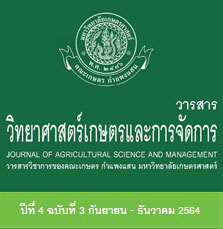การคัดแยกแบคทีเรียย่อยสลายสารไซเพอร์เมทรินจากดินในพื้นที่เกษตรกรรม
คำสำคัญ:
ไซเพอร์เมทริน, การย่อยสลายทางชีวภาพ, แบคทีเรียย่อยสลายไซเพอร์เมทรินบทคัดย่อ
ไซเพอร์เมทรินเป็นสารกำจัดแมลงศัตรูพืชที่เกษตรกรเลือกใช้อย่างแพร่หลาย และเป็นสารที่คงทนต่อการย่อยสลายทางกายภาพ ส่งผลให้เกิดการสะสมหรือปนเปื้อนในสิ่งแวดล้อม และอาจจะก่อให้เกิดผลกระทบต่อสุขภาพของมนุษย์และสัตว์ งานวิจัยนี้จึงสนใจคัดแยกแบคทีเรียย่อยสลายสารไซเพอร์เมทรินจากดินในพื้นที่เกษตรกรรมที่มีการใช้สารไซเพอร์เมทรินมาเป็นระยะเวลานานจากบริเวณที่เพาะปลูกขึ้นฉ่าย คะน้า และแตงกวา พบว่าสามารถแยกแบคทีเรียย่อยสลายไซเพอร์เมทรินได้ 21 16 และ 15 ไอโซเลท ตามลำดับ แล้วนำแบคทีเรียที่คัดแยกได้ทั้งหมดมาทดสอบประสิทธิภาพการย่อยสลายไซเพอร์เมทรินในอาหารเหลว mineral salt medium (MSM) ที่มีสารไซเพอร์เมทรินเข้มข้น 100 มิลลิกรัม/ลิตร พบว่ามีแบคทีเรีย 10 ไอโซเลท ที่มีประสิทธิภาพในการย่อยสลายไซเพอร์เมทรินมากกว่า ร้อยละ 60 ได้แก่ A21 B1 B3 B6 B13 C8 C9 C10 C11 และ C13 เมื่อระบุชนิดของแบคทีเรียด้วยวิธีทางชีวโมเลกุล โดยการวิเคราะห์ลำดับ 16S rRNA พบว่าเป็นแบคทีเรียที่แตกต่างกันทั้งหมด 6 สกุล และ 7 สปีชีส์ โดยเป็นแบคทีเรียที่ทราบสปีชีส์จำนวน 5 สปีชีส์ ดังนี้ Acinetobacter baumannii, Azoarcus olearius, Phenylobacterium haematophilum, Pseudomonas nitroreducens, และ Shinella zoogloeoides และมีแบคทีเรียที่คาดว่าอาจเป็นแบคทีเรียสปีชีส์ใหม่ 2 สกุล คือ Pseudoxanthomonas และ Pseudomonas โดย A. baumannii B3 มีประสิทธิภาพในการย่อยสลายไซเพอร์เมทรินมากที่สุดคือ ร้อยละ 93 โดยมีปริมาณไซเพอร์เมทรินคงเหลือ 3.8 มิลลิกรัม/ลิตร หลังจากทดสอบการย่อยสลายเป็นเวลา 7 วัน จากการศึกษาครั้งนี้จะสามารถนำแบคทีเรียที่มีประสิทธิภาพสูงในการย่อยสลายไซเพอร์เมทรินไปศึกษาและพัฒนาเป็นผลิตภัณฑ์หัวเชื้อแบคทีเรียเพื่อการบำบัดพื้นที่ปนเปื้อนไซเพอร์เมทริน
เอกสารอ้างอิง
โชติมา วิไลวัลย์. 2549. สารฆ่าแมลง. (ระบบออนไลน์). แหล่งข้อมูล: http://www.chemtrack.org/News-Detail.asp?TID=4&ID=4 (13 กรกฎาคม 2564).
Akbar, S., S. Sultan and M. Kertesz. 2015. Determination of cypermethrin degradation potential of soil bacteria along with plant growth-promoting characteristics. Current Microbiology 70: 75-84.
Akbar, S. and S. Sultan. 2016. Soil bacteria showing a potential of chlorpyrifos degradation and plant growth enhancement. Brazilian Journal of Microbiology 47: 563-570.
Ali, S.S., H. Mazhar and T. Riaz. 2011. Screening and characterization of cypermethrin degrading bacteria from polluted samples. Punjab University Journal of Zoology 26(1): 59-74.
Ashengroph, M., I. Nahvi, H. Zarkesh-Esfahani and F. Momenbeik. 2011. Pseudomonas resinovorans SPR1, a newly isolated strain with potential of transforming eugenol to vanillin and vanillic acid. New Biotechnology 28(6): 656-664.
Aswathi, A., A. Pandey and R.K. Sukumaran. 2019. Rapid degradation of the organophosphate pesticide-chlorpyrifos by a novel strain of Pseudomonas nitroreducens AR-3. Bioresource Technology 292: https://doi.org/10.1016/j.biortech.2019.122025.
Azmy, A.F., A.E. Saafan, T.M. Essam, M.A. Amin and S.H. Ahmed. 2015. Biodegradation of malathion by Acinetobacter baumannii strain AFA isolated from domestic sewage in Egypt. International Journal of Biological, Food, Veterinary and Agricultural Engineering 9(1): 55-65.
Bai, Y., Q. Sun, C. Zhao, D. Wen and X. Tang. 2009. Aerobic degradation of pyridine by a new bacterial strain, Shinella zoogloeoides BC026. Journal of Industrial Microbiology and Biotechnology 36: 1391-1400.
Chen, M.H., S.Y. Sheu, E.K. James, C.C. Young and W.M. Chen. 2013. Azoarcus olearius sp. nov., a nitrogen-fixing bacterium isolated from oil-contaminated soil. International Journal of Systematic and Evolutionary Microbiology 63: 3755-3761.
Cycon, M. and Z. Piotrowska-Seget. 2016. Pyrethroid-degrading microorganisms and their potential for the bioremediation of contaminated soil: a review. Frontiers in Microbiology 7: https://doi:10.3389/fmicb.2016.01463.
de Souza Rocha, A.F., L.C. Vitorino, L.A. Bessa, R.R. Guedes Fonseca Cost, M. da Silva Brasil and E.L. Souchie. 2020. Soil parameters affect the functional diversity of the symbiotic microbiota of Hymenaea courbaril L., a Neotropical fruit tree. Rhizosphere 16: https://doi.org/10.1016/j.rhisph.2020.100237.
Deng, F., J. Sun, R. Dou, X. Yu, Z. Wei, C. Yang, X. Zeng and L. Zhu. 2020. Contamination of pyrethroids in agricultural soils from the Yangtze River Delta, China. Science of the Total Environment 731: https://doi.org/10.1016/j.scitotenv.2020.139181.
Dua, M., A. Singh, N. Sethunathan and A.K. Johri. 2002. Biotechnology and bioremediation: successes and limitations. Applied Microbiology and Biotechnology 59: 143-152.
Faoro, H., R.R. Menegazzo, F. Battistoni, P. Gyaneshwar, F.P. do Amaral, C. Taulé, S. Rausch, P.G. Galvão, C. de los Santos, S. Mitra, G. Heijo, S. Sheu, W. Chen, C. Mareque, M.Z. Tadra-Sfeir, J.I. Baldani, M. Maluk, A.P. Guimarães, G. Stacey, E.M. de Souza, F.O. Pedrosa, L.M. Cruz and E.K. James. 2017. The oil-contaminated soil diazotroph Azoarcus olearius DQS-4T is genetically and phenotypically similar to the model grass endophyte Azoarcus sp. BH72. Environmental Microbiology Reports 9(3): 223-238.
Howard, A., M. O’Donoghue, A. Feeney and R.D. Sleator. 2012. Acinetobacter baumannii: an emerging opportunistic pathogen. Virulence 3(3): 243-250.
Huang, Y., L. Xiao, F. Li, M. Xiao, D. Lin, X. Long and Z. Wu. 2018. Microbial degradation of pesticide residues and an emphasis on the degradation of cypermethrin and 3-phenoxy benzoic acid: a review. Molecules 23: https://doi: 10.3390/molecules23092313.
Jabeen, F., M. Ahmed, F. Ahmed, M.B. Sarwar, S. Akhtar and A.A. Shahid. 2017. Characterization of cypermethrin degradaing bacteria: a hidden micro flora for biogeochemical cycling of xenobiotics. Advancements in Life Sciences 4: 97-107.
Lingens, F., R. Blecher, H. Blecher, F. Blobel, J. Eberspächer, C. Fröhner, H. Görisch and G. Layh. 1985. Phynylobacterium immobile gen. nov., sp. nov., a Gram-negative bacterium that degrades the herbicide chloridazon. International Journal of Systematic Bacteriology 35(1). 26-39.
Liu, S., K. Yao, D. Jia, N. Zhao, W. Lai and H. Yuan. 2012. A pretreatment method for HPLC analysis of cypermethrin in microbial degradation systems. Journal of Chromatographic Science 50: 469-476.
Liu, J. Y., Ding, L. Ma, G. Gao and Y. Wang. 2017. Combination of biochar and immobilized bacteria in cypermethrin-contaminated soil remediation. International Biodeterioration & Biodegradation 120: 15-20.
Shree, M. and P.R. Iyer. 2017. Degradation and bioremediation of the pesticide cypermethrin by Pseudomonas spp. and Bacillus spp. Journal of Chemical, Biological and Physical Sciences 8(1): 16-27.
Stackebrandt, E. and J. Ebers. 2006. Taxonomic parameters revisited: tarnished gold standards. Microbial Today 33: 152-155.
Wang, G., J. Zhang, L. Wang, B. Liang, K. Chen, S. Li and J. Jiang. 2010. Co-metabolism of DDT by the newly isolated bacterium, Pseudoxanthomonas sp. WAX. Brazilian Journal of Microbiology 41: 431-438.
Zhan, H., H. Wang, L. Liao, Y. Feng, X. Fan, L. Zhang and S. Chen. 2018. Kinetics and novel degradation pathway of permethrin in Acinetobacter baumannii ZH-14. Frontiers in Microbiology 2: doi: 10.3389/fmicb.2018.00098.
Zhang, B., H. Zhang, B. Jin, L. Tang, J. Yang, B. Li, G. Zhuang and Z. Bai. 2008. Effect of cypermethrin insecticide on the microbial community in cucumber phyllosphere. Journal of Environmental Sciences 20(11): 1356-1362.






